| |
 |
 |
| |
|
Tunisia |
| |
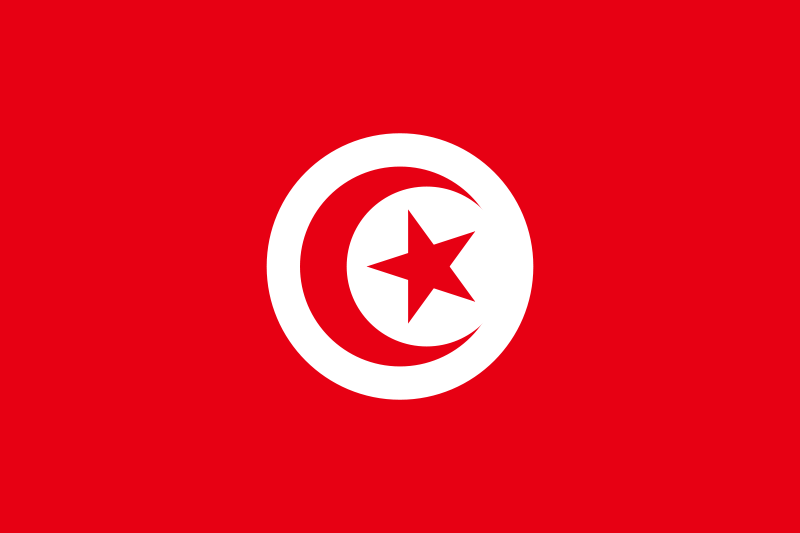 |
 |
|
|
| Tunisia is
situated the coast of central North Africa, where the sea suddenly turns
south toward Libya. Capital: Tunis. |
| Motto: حرية،
نظام، عدالة "Ḥurriyyah, Nizām, Adālah" (Liberty, Order, Justice). |
| |
1135 - 1158 Djerba Island
taken by Norman Kingdom of Sicily.
1146 - 1160
Tunis occupied by Norman Kingdom of Sicily.
1236 Hafsid Kingdom.
1284 - 1333
Lordship of Djerba under the Kingdom of Sicily.
1520 Inhabitants of Djerba
swore vassalage to the king of Spain,
but no Spanish occupation takes place.
1531 Vassal of Ottoman
Empire.
14 Jul 1535 - Jan 1570 Tunis and La Goletta (to 23
Aug 1574) occupied by Spain.
1535 - 1574
Bizerte (Biserta) occupied by Spain.
1542 Island of Tabarca
granted to the Lomellini family of Genoa.
08 Mar 1560 - 31 Jul 1560 Djerba Island Occupied by Spain.
Jan 1570 - 10 Oct 1573 Tunis under
Ottoman suzerainty.
10 Oct 1573 - 03 Sep 1574 Tunis occupied by Spain.
03 Sep 1574 - 10 Aug 1920 Incorporated into Ottoman Empire, with
varying and ultimately
increased autonomy (1726-1821 subordinated to Algiers).
15 Jul 1705 Tunisian Regency under de facto hereditary Husayni
dynasty.
18 Jun 1741 Island of Tabarca Surrendered to the Bey of Tunis.
25 Oct 1871 While continuing to recognize nominal Ottoman suzerainty,
the
Bey ceases paying tribute.
03 May 1881 France takes possession of Bizerte.
12 May 1881 Tunisia becomes a French protectorate by treaty.
10 Oct 1881 French occupation of Tunis.
22 Jun 1940 - 07 May 1943 Administration loyal to Vichy France (from
7 May 1943,
Free French).
10 Nov 1942 - 07 May 1943 Occupied by Germany.
03 Jun 1955 Autonomous.
20 Mar 1956 French protectorate terminated. State styled Tunisian
Realm
(al-Mamlaka at-Tunisiyya - literally Tunisian Kingdom; this
style already appears on 1950 coins).
France retains Bizerte (Strategic Base of Bizerte).
25 Jul 1957 Tunisian Republic.
01 Jun 1959 Tunisian Constitution becomes effective.
05 Sep 1961 France recognizes Tunisian sovereignty over Bizerte and
agrees
withdraw upon cessation of hostilities in Algeria.
15 Oct 1963 France evacuates Bizerte.
17 Dec 2010 Tunisian street vendor Mohamed Bouazizi set himself on fire
in protest to police harassment, triggering the Tunisian
Revolution. |
| |
| |
|
|
|
|
|
Ottoman Emperor: Mahmud
I coinage of Tunisia: 1730 - 1754 [AH 1143-1168]. |
|
Currency:
Riyal Sebili (Piastre) = 16 Khurub (Caroub) = 52 Nasri (Asper) = 104 Fals
(Bourbe) = 624 Qafsi (Fals Raqiq or Bourbine). |
|
|
|
 |
KM#49
Khurab. Year:
AH 1167 (1754 CE). Weight:
0.96g [1.33]. Metal:
Billion.
Diameter:
14.50 mm. Edge:
Plain. Alignment:
Rotated. Mint:
Tunis. Obverse:
"ضرب في تونس"
(Struck at Tunis) in Arabic in the center with Date at the bottom.
Reverse: "سلطان
محمود"
(Sultan Mahmud).
Mintage:
N/A.
Minted Years:
AH1167 and AH1168/7. |
|
|
|
|
Ottoman Emperor: Mustafa III coinage of Tunisia: 1757 - 1774 [AH 1171-1187]. |
|
|
|
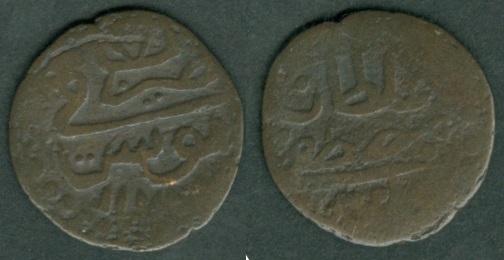 |
KM#52.2
Burbe / Fals. Year:
AH 1172 (1758 CE). Weight:
2.95g [3.30 - 4.60g]. Metal:
Copper.
Diameter:
20.50 mm. Edge:
Plain. Alignment:
Medal. Mint:
Tunis. Obverse:
"ضرب في تونس"
(Struck at Tunis) in Arabic in the center with Date at the bottom.
Reverse: "سلطان
مصطفى خان"
(Sultan Mustafa Khan).
Mintage:
N/A.
Minted Years:
AH 1171-1187 (1757-1774). |
|
 |
Same as above coin, KM#52.2...
Year:
AH 1173 (1759 CE). Weight:
3.71g.
Diameter:
20.00 mm. Alignment:
Rotated. |
|
|
|
|
Ottoman Emperor:
Selim
III coinage of Tunisia: 1789 - 1807 [AH
1203 - 1223] |
|
|
|
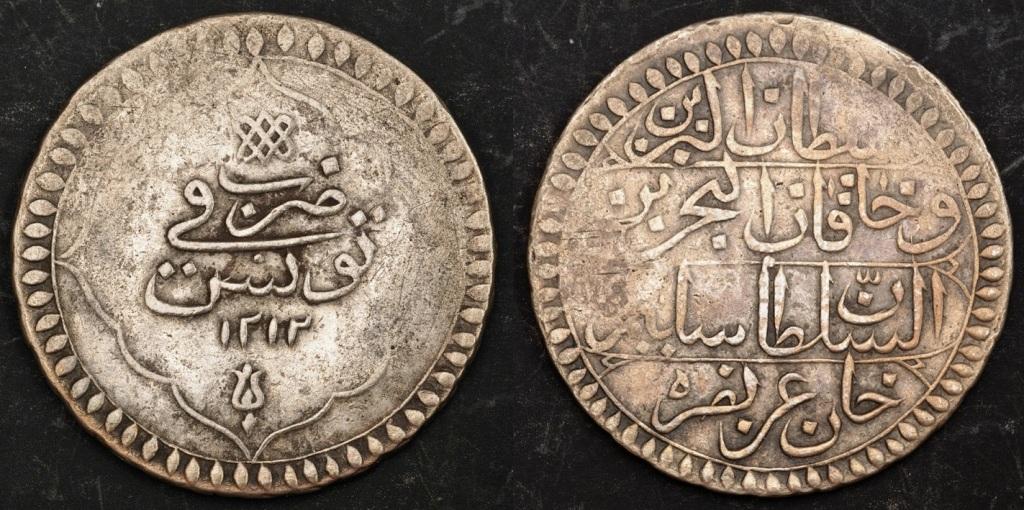 |
| KM#72.2
Piastre. Year:
AH 1212 (1797 CE).
Weight:
13.31g [14.90 - 16.00g]. Metal:
Billion.
Diameter:
34.00 mm. Edge:
Decorative. Alignment:
Medal. Mint:
Tunis. |
 |
| Obverse:
Ornamentation at the top. "ضرب في تونس" (Struck at Tunis) in Arabic in
the center with Date at the bottom within hexafoil. Abstract flower
design below Date. Reverse: "سلطان
البرين و خاقان البحرين السلطان
سليم خان عز نصرة"
[sultan al-barain wa khaqan
al-bahrain al-sultan Mahmud Khan az nasrah (Sultan of the two lands and
Khaqan of the two seas, the Sultan, Selim Khan, may his victory be
glorious)] in Arabic on ornate field within four linear lozenges; all
within circular linear and decorative border.
Mintage:
N/A.
Minted Years:
AH 1206-1222 (1791-1807). Note:
Varieties in ornamentation exist. |
|
|
|
|
Ottoman Emperor: Mahmud II coinage of Tunisia: 1808 - 1839 [AH 1223-1255]. |
|
Currency:
Riyal Sebili (Piastre) = 16 Khurub (Caroub) = 52 Nasri (Asper) = 104 Fals
(Bourbe) = 624 Qafsi (Fals Raqiq or Bourbine). |
|
|
|
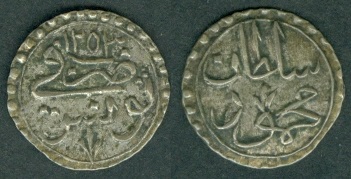 |
KM#91
Khurab. Year:
AH 1253 (1837 CE). Weight:
0.68g [0.60-0.70g]. Metal:
Billion.
Diameter:
14.00 mm. Edge:
Plain. Alignment:
Medal. Mint:
Tunis. Obverse:
"ضرب في تونس"
(Struck at Tunis) in Arabic in the center with Date at the top.
Reverse: "سلطان محمود"
(Sultan Mahmud) within center circle.
Mintage:
N/A.
Minted Years:
AH 1229, AH 1241-1242 and AH 1249-AH1255 (1814, 1825-1826, 1833-1839). |
|
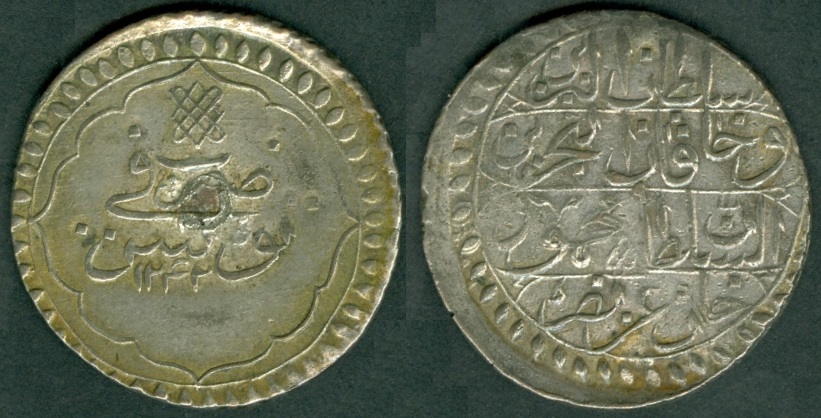 |
| KM#90
Piastre. Year:
AH 1242 (1826 CE). Weight:
11.70g [11.50g]. Metal:
Billion.
Diameter:
33.00 mm. Edge:
Decorative. Alignment:
Medal. Mint:
Tunis. Obverse:
Ornamentation at the top. "ضرب في تونس" (Struck at Tunis) in Arabic in
the center with Date at the bottom within hexafoil.
Reverse: "سلطان
البرين و خاقان البحرين السلطان محمود خان عز نصرة"
[sultan al-barain wa khaqan
al-bahrain al-sultan Mahmud Khan az nasrah (Sultan of the two lands and
Khaqan of the two seas, the Sultan, Muhmud Khan, may his victory be
glorious)] in Arabic on ornate field within four linear lozenges; all
within circular linear and decorative border.
Mintage:
N/A.
Minted Years:
AH 1240-1255 (1824-1839). Note:
Varieties in ornamentation exist. |
|
|
|
|
Ottoman Emperor: Abdul Mejid
Khan coinage of Tunisia: 1839 - 1855 [AH 1255-1271]. |
|
Currency:
Riyal Sebili (Piastre) = 16 Khurub (Caroub) = 52 Nasri (Asper) = 104 Fals
(Bourbe) = 624 Qafsi (Fals Raqiq or Bourbine). |
|
|
|
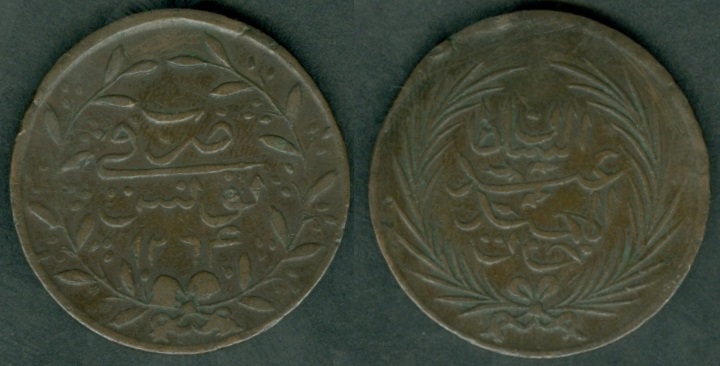 |
|
KM#104.2
6 Nasri. Year:
AH 1264 (1848 CE). Weight:
11.58g [11.50g]. Metal:
Copper.
Diameter:
29.00 mm. Edge:
Plain. Alignment:
Medal. Mint:
Tunis. Obverse:
"ضرب في تونس" (Struck at Tunis) in Arabic in
the center with Date within circular wreath.
Reverse: "السلطان عبد المجيد خان"
(al-Sultan Abdul Majid Khan) in Arabic in center circle
with four leaves design, surrounded by wreath.
Mintage:
N/A.
Minted Years:
AH 1263-1271 (1847-1855). |
|
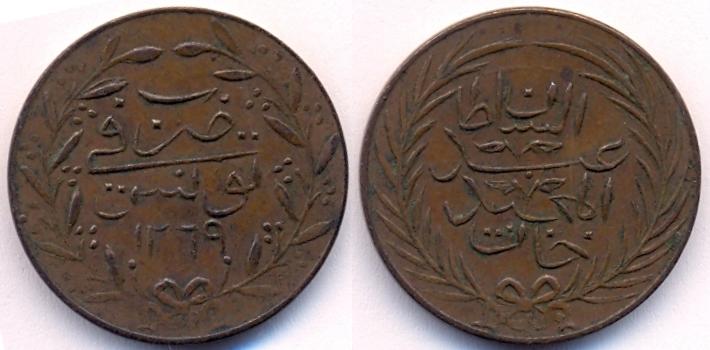 |
| Same as above coin, KM#104.2...
Year:
AH 1269 (1853 CE). Weight:
11.62g [11.50g]. |
|
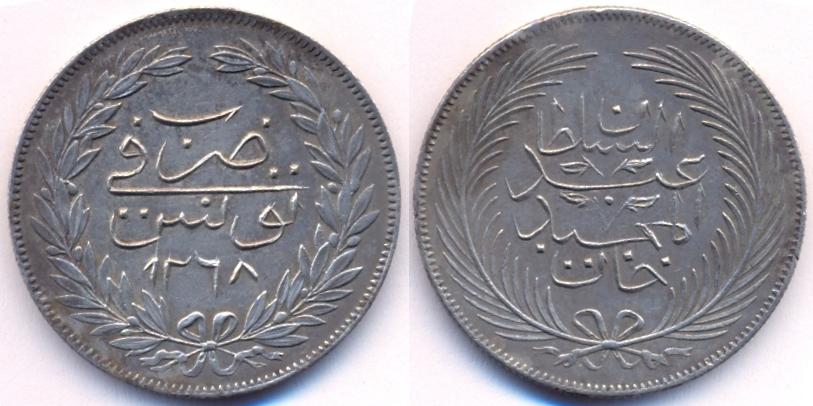 |
|
KM#108
5 Piastres. Year:
AH 1268 (1852 CE). Weight:
15.72g [16.50g]. Metal:
0.900 Silver.
Diameter:
33.00 mm. Edge:
Reeded. Alignment:
Medal. Mint:
Tunis. Obverse:
"ضرب في تونس" (Struck at Tunis) in Arabic in
the center with Date within circular wreath.
Reverse: "السلطان عبد المجيد خان"
(al-Sultan Abdul Majid Khan) in Arabic in center circle
with four leaves design, surrounded by wreath.
Mintage:
N/A.
Minted Years:
AH 1265-1271 (1849-1855). |
|
|
|
|
|
- France..........................................10
Oct 1881 - 20 Mar 1956
- Bey [Husainid dynasty]
- Ali Muddat ibn al-Husayn II................28
Oct 1882 - 11 Jun 1902
- Muhammad IV al-Hadi ibn Ali................11
Jun 1902 - 11 May 1906
- Muhammad V an-Nasir ibn M.
al-Hadi.........11
May 1906 - 10 Jul 1922
- Muhammad VI al-Habib ibn M.
al-Ma'mum......10
Jul 1922 - 11 Feb 1929
- He succeeded as Bey of Tunis on the death
of his cousin Muhammad V an-Nasir.
- Ahmad II ibn Ali Muddat....................11
Feb 1929 - 19 Jun 1942
- Muhammad VII al-Munsif ibn M.
an-Nasir.....19
Jun 1942 - 15 May 1943 d. 1948
- Tunisian documents and coinage refer to the state as a Kingdom from
1950.
- Muhammad VIII al-Amin ibn M.
al-Habib......15
May 1943 - 20 Mar 1956 d. 1962
- Kingdom
- Muhammad VIII al-Amin (continued)...............20
Mar 1956 - 25 Jul 1957 d. 1962
- After several arduous negotiations,
independence was proclaimed on March 20, 1956, with Habib Bourguiba as
president of the "National Constituent Assembly", and Head of the
Government. At the same time, he acted as the Minister of Foreign
Affairs of Tunisia. On July 25, 1957, a republic was proclaimed
abolishing the monarchy and vesting Bourguiba with powers of President
of the Republic. Bourguiba's long and powerful presidency was formative
for the creation of the Tunisian state and nation.
- Husain
en-Nasr................................................1957
- Rashad al-Mahdi...............................................1957
- Republic - Presidents
- al-Habib Bourguiba ibn Ali Abu
Ruqayba..........25 Jul 1957 - 07 Nov 1987
- He also served as Prime Minister from 11 Apr
1956 to 25 Jul 1957. On November 7, 1987 Prime Minister Zine El Abidine
Ben Ali, in a coup d'état, declared President Habib Bourguiba impeached
on medical grounds and constitutionally replaced him as President of
Tunisia, on the basis of a strict reading of Article 57.
- Zine El Abidine Ben
Ali.........................07 Nov 1987 - 14 Jan 2011
- He also served as Prime Minister from 02 Oct
1987 to 07 Nov 1987.
- Mohamed Ghannouchi (interim)....................14
Jan 2011 - 15 Jan 2011
- Fouad Mebazaa (interim).........................15
Jan 2011 - 13 Dec 2011
- Mohamed Moncef Marzouki (interim)...............13
Dec 2011 - 31 Dec 2014
- Mohamed Béji Caïd Essebsi.......................31
Dec 2014 - 25 Jul 2019
- He was a Tunisian politician who was the fifth
President of Tunisia from December 2014 until his death. Previously he
served as Minister of Foreign Affairs from 1981 to 1986 and as Prime
Minister from February 2011 to December 2011. Essebsi was sworn in as
President on 31 December 2014 at the age of 88. On 27 June 2019, Essebsi
was hospitalized at a military hospital in Tunis due to a serious
illness. The following day his condition stabilized. He died on 25 July
2019 at the age of 92, after being readmitted to hospital the previous day. Essebsi died
five months before the end of his term in office.
- Mohamed Ennaceur
(interim)......................25 Jul 2019 -
23 Oct 2019
- He became Acting President of Tunisia 25 July
2019 upon the death of President Beji Caid Essebsi. Since 04 December
2014, he has been the President of the Assembly of the Representatives
of the People and leader of the governing Nidaa Tounes party. Previously
he served as Minister of Social Affairs in the 1970s and 1980s under
President Habib Bourguiba, and again in 2011 in the transitional
Ghannouchi and Essebsi governments. According to Article 84 of the
Tunisian constitution, an interim president may serve in their role for
a maximum of 90 days, meaning Ennaceur's role is due to expire on 23
October 2019. In the first round of presidential elections on 15
September 2019, Kaïs Saïed (independent) wins 18.4% of the vote, Nabil
Karoui (Heart of Tunisia) 15.6%, Abdelfattah Mourou (Ennahda) 12.9%,
Abdelkrim Zbidi (independent) 10.7%, Prime Minister Youssef Chahed (Long
Live Tunisia) 7.4%, Safi Saïd (independent) 7.1%, and Lotfi Mraihi
(Republican People's Union) 6.6%. Turnout is 45.0%. The date for the
runoff is subsequently announced as 13 October 2019. On 13 October 2019, in
the presidential runoff, Kaïs Saïed wins 72.7% of the vote and Nabil
Karoui 27.3%. Turnout is about 55%. Saïed is sworn in on October 23.
- Kaïs Saïed......................................23
Oct 2019 - date
- On 29 October 2019, Kaïs Saïed approves
the dismissal of Foreign Minister Khemaies Jhinaoui and Defense Minister
Abdelkrim Zbidi; Sabri Bachtobji becomes acting foreign minister and
Justice Minister Karim Jamoussi acting defense minister. On 15 November
2019, President Kaïs Saïed asks Habib Jemli to form a government. On 02
January 2020, Prime minister-designate Habib Jemli announces his
government, including Khaled Shili as foreign minister, Imed Derouiche
as defense minister, Sofiene Selliti as interior minister, and
Abderrahmen Khachtali as finance minister. In the confidence vote on 10
January 2020, however, parliament rejects the government (134-72). On 15
February 2020, Prime minister-designate Elyes Fakhfakh announces his
government including Noureddine Erray as foreign minister, Imed Hazgui
as defense minister, Hichemi Mechichi as interior minister, and Mohamed
Nizar Yaïch as finance minister. On February 27 the parliament gives its
confidence (129-77) and the government is sworn in. On 15 July 2020,
Prime Minister Elyes Fakhfakh resigns. On 17 July, President Kaïs Saïed
asks the parliamentary parties to submit by 22 July their proposed
candidates for the post of prime minister. On 23 July, Foreign Minister
Noureddine Erray is dismissed. Officially on 24 July, Salma Ennaifer is
appointed acting foreign minister. On 25 July, the president chooses
Interior Minister Hichem Mechichi as new prime minister. On 24 August
2020, Prime minister-designate Hichem Mechichi names his government with
Othman Jerandi as foreign minister, Ibrahim Bartagi as defense minister,
Taoufik Charfeddine as interior minister, and Ali Kooli as finance
minister. On 02 September 2020, the government of prime
minister-designate Hichem Mechichi is approved by parliament (134-67)
and sworn in.
|
|
|
|
|
|
Further Coinage of Tunisia are listed under:
|
| |
|
|
| |
|
|
| Countries
/ Territories |
| |
|
Chiefa Coins | |
|













